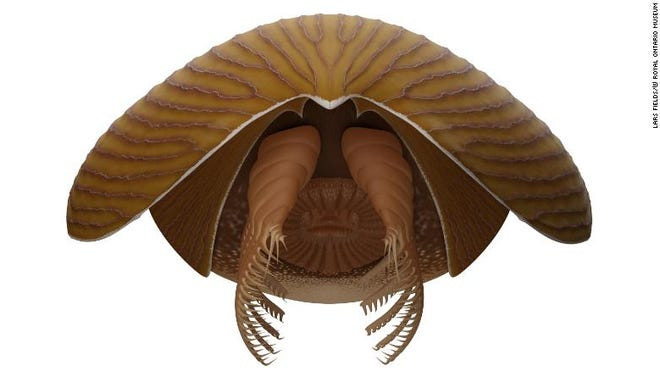Paleontologists from the Royal Ontario Museum (ROM) discovered the remnants of a massive new fossil species called Titanokorys gainesi, which belonged to an extinct animal group in Cambrian rocks from Kootenay National Park in the Canadian Rockies, dating back half a billion years.
Titanokorys literally means "titanic helmet," and for good reason. The head carapace of this animal accounted for about two-thirds of its 50-centimetre body length.
While that may not appear to be a large by today's standards, it was a behemoth during the Cambrian Period, a critical period in the evolution of life on Earth.
"The sheer size of this animal is absolutely mind-boggling," ROM's Jean-Bernard Caron said. "This is one of the biggest animals from the Cambrian period ever found."
"The head is so long compared to the body that these animals are really little more than swimming heads," Joe Moysiuk, co-author of the new study, said.
The Cambrian period lasted around 541 to 485 million years ago. It was a significant period in the evolution of life on Earth because it saw a great expansion in diversity, with the emergence of most of the major groups of creatures we know today, from arthropods and mollusks to echinoderms and chordates (us).
Titanokorys is a radiodont, which is a group of primitive arthropods. The most notable member of this group is the streamlined predator Anomalocaris, which may have reached a metre in length.
Lke all radiodonts, it had multifaceted eyes, a pineapple slice-shaped, tooth-lined mouth, a pair of spiky claws beneath its head for prey capture, and a body with a series of flaps for swimming.
Some species in this group also have huge, conspicuous head carapaces, Titanokorys being one of the largest ever discovered.
Titanokorys ate buried prey like worms, stirring up the mud and straining out any morsels with its claws. Its claws were adapted to transport food to its mouth rather than grasping prey.
When the carapace fossils were discovered, they were so odd that scientists were unsure what kind of animal they belonged to.
Scientists have dubbed them "the mothership."
A smaller cousin discovered in the Burgess Shale, a treasure mine of Cambrian fossils, was given the nickname 'spaceship.'
Between 2014 and 2018, paleontologists uncovered partial fossils of at least a dozen Titanokorys individuals in British Columbia.






